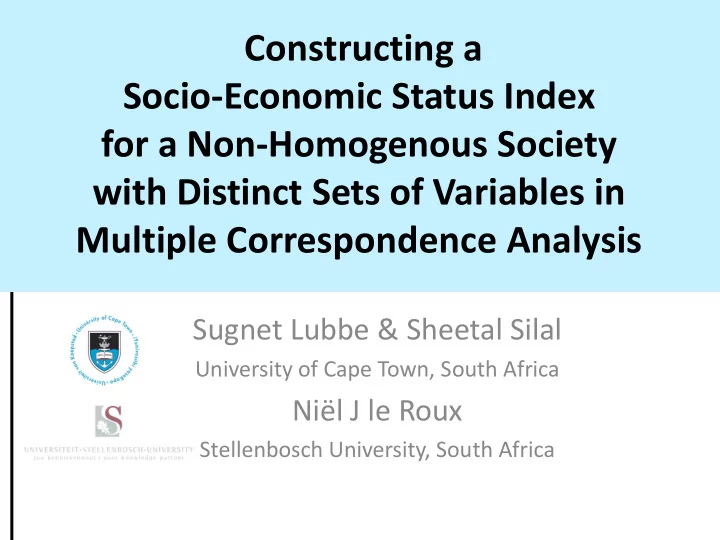

Constructing a Socio-Economic Status Index for a Non-Homogenous Society with Distinct Sets of Variables in Multiple Correspondence Analysis Sugnet Lubbe & Sheetal Silal University of Cape Town, South Africa Niël J le Roux Stellenbosch University, South Africa
Socio-Economic Status: Wikipedia • Socio-economic status (SES) is an economic and sociological combined total measure of a person's work experience and of an individual's or family’s economic and social position relative to others, based on income, education, and occupation. • A fourth variable, wealth, may also be examined when determining socio- economic status.
Background • Maternity ward • Eight state hospitals – Population primarily Black South Africans – few Coloured South Africans – Exit interview – Review of hospital record
Aim – Among other objectives • Find a Socio-Economic Status Index – based on three groups of variables • Asset variables – Does your household have any of the following in good working order? • Household physical characteristics – What is the main material of your house’s walls / roof? – What is your main source of drinking water? • Demographic variables of household head – sex / age / education / employment
Asset variables Technology Traditional • Does your household own • Does your household have any of the following in good working order? cattle, livestock or chickens? • Landline • How many does your • Cellphone household own? • Radio – cattle • TV • Video / DVD – goats • Electric stove with oven – chickens • Bicycle – pigs • PC – other • Internet • 1 Guinea fowl Poultry • Fridge • Vehicle
Constructing a SES index: Asset vars • How do we combine these two ways of living into a single SES index? • ... economic and social position relative to others ... – technology: more ‘devices’, higher SES – traditional: more livestock, higher SES • relative to other traditional households – Single SES, relative to ALL others in South Africa???
MCA of Technology variables internet.1 1.0 0.5 PC.1 TV.0 cellphone.0 landline.1 fridge.0 radio.0 vehicle.1 bicycle.1 DVD.0 stove.1 stove.0 0.0 cellphone.1 internet.0 bicycle.0 radio.1 fridge.1 landline.0 TV.1 DVD.1 vehicle.0 PC.0 -1.0 -0.5 0.0 0.5 higher SES
MCA of all Asset variables (Tech & Trad) poultry.20 poultry.34 Cattle Goats Poultry goats.5 cellphone.0 internet.1 fridge.0 poultry.3 goats.2 poultry.4 poultry.10 TV.0 poultry.2 poultry.14 poultry.6 radio.0 goats.3 poultry.5 pigs.3 TV.1DVD.0 pigs.4 pigs.0 poultry.0 goats.0 goats.26 goats.8 stove.1 cattle.8 cellphone.1 cattle.0 bicycle.0 cattle.6 PC.1 landline.1 cattle.7 poultry.15 fridge.1 internet.0 landline.0 goats.4 PC.0 vehicle.0 bicycle.1 DVD.1 radio.1 stove.0 vehicle.1 cattle.10 0 6 8 5 4 15 34 0 0 0 20 2 3 7 26 6 8 3 10 14 4 poultry.8 10 5 2 8 -2 cattle.2 2 goats.1 1 -4 1 poultry.1 pigs.2 Pigs -6 0 4 2 6 goats.6 -8 9 cattle.9 -10 3 -6 -4 -2 0 2 4 6 higher SES
Naive combination of components MCA 1 st component: combined components 2 1 cattle goats poultry 0 pigs -1 -2 -2 -1 0 1 2 MCA 1 st component: technology only higher SES
Correlations: all Asset variables cellphone internet poultry bicycle vehicle fridge cattle radio stove goats DVD pigs TV PC landline 0.04 0.12 0.15 0.19 0.26 0.22 0.33 0.15 0.15 0.33 -0.04 -0.02 -0.03 -0.04 cellphone 0.17 0.23 0.21 0.12 0.06 0.10 0.02 0.16 0.08 0.03 0.03 0.03 0.03 radio 0.28 0.27 0.15 0.11 0.10 0.06 0.28 0.13 0.03 0.02 0.04 0.04 TV 0.55 0.31 0.14 0.15 0.07 0.45 0.19 0.03 -0.01 -0.01 0.03 DVD 0.34 0.19 0.23 0.11 0.36 0.24 -0.01 0.00 -0.05 -0.04 stove 0.20 0.29 0.13 0.39 0.31 -0.05 -0.07 -0.04 0.00 bicycle 0.19 0.08 0.11 0.23 -0.03 -0.02 0.06 0.04 PC 0.38 0.14 0.39 -0.04 -0.04 -0.06 -0.04 Internet 0.06 0.17 -0.02 -0.02 -0.03 -0.01 fridge 0.02 0.03 0.04 0.00 0.04 vehicle 0.03 -0.02 0.00 0.03 cattle 0.24 0.11 0.30 goats 0.21 0.11 poultry 0.06
Variable types • Technology – 0 / 1 • Traditional – Count: positive whole numbers – ‘continuous’ • PCA biplot – Euclidean distance on 0/1 coding Extended matching coefficient – ‘Generalised biplot’ – Scaled data matrix: all variances = 1
PCA biplot of all Asset variables poultry goats cattle pigs 5 6 8 4 5 1 cellphone 6 4 3 radio 3 4 fridge 2 TV 2 2 1 DVD 1 0 stove bicycle vehicle internet PC landline
MCA with indicators only cattle goats poultry pigs own ‘device’ do not own ‘device’
MCA of livestock owners only Cattle Goats PC.1 poultry.20 poultry.2 stove.1 poultry.15 poultry.6 pigs.3 poultry.5 pigs.4 goats.5 cattle.8 8 5 poultry.3 bicycle.1 poultry.14 landline.1 goats.8 cattle.7 7 8 poultry.4 cellphone.0 poultry.10 goats.0 0 radio.0 pigs.0 cattle.0 0 goats.2 vehicle.1 2 goats.26 fridge.1 26 internet.0 cellphone.1 TV.1 DVD.1 landline.0 DVD.0 PC.0 radio.1 TV.0 vehicle.0 cattle.10 10 goats.3 bicycle.0 3 poultry.34 cattle.6 6 fridge.0 goats.4 4 stove.0 poultry.0 poultry.8 cattle.2 2 goats.1 1 poultry.1 pigs.2 goats.6 6 Pigs Poultry cattle.9 9 3 4 20 2 15 6 5 0 3 14 4 10 34 0 8 1 2
Difficulties in merging components • Essentially 2 components – orthogonal to each other • uncorrelated • measure different ‘aspects’ – technology vs tradition • Options – finite (2) mixtures – principal components – non-parametric principal components (prin. curves) – canonical correlation analysis – ?????
In conclusion • Statistical plots – MCA & PCA – INDISPENSIBLE to explore the structure of the data – clearly indicates orthogonality of components • Statistics – Show what the data is telling us – Cannot merge contrasting components – Measure different aspects • Technology vs Tradition
Recommend
More recommend